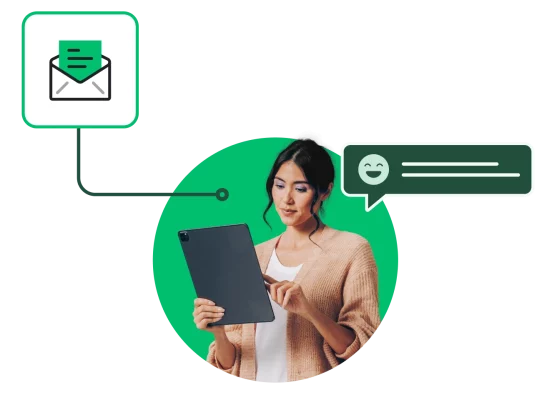Best practices and channels for sending surveys

- You can increase response rates by using a survey distribution method that aligns with your goal.
- The best ways to send a survey include a web link, email invitation, social media, Facebook Messenger, field survey, and text message.
- The best way to send a survey depends on your target audience. However, a multi-channel approach ensures maximum reach and response.
Effectively distributing surveys is crucial for gathering meaningful and actionable feedback.
Understanding the strengths of each method will enable you to choose the most appropriate strategy for your needs, ensuring that you collect the valuable insights necessary for informed decision-making.
In this guide, we’ll explore the best ways to send a survey. From traditional email and social media platforms to innovative SMS and QR code techniques, these approaches can help you reach a broader audience and increase response rates.
Best channels for sending surveys
1. Web link
A survey web link is a URL or QR code that directs respondents to an online survey. Web links can be shared through various digital channels, such as email and social media, while you can distribute QR codes via physical means, including PowerPoint presentations and flyers.
Web links have several pros that you should consider.
- QR codes are a quick and straightforward way to access a survey. Respondents scan the QR code with a smartphone camera, eliminating user error made from typing in a web address.
- You can reach a greater audience using QR codes by placing them on posters, flyers, and business cards.
- Because web links, like QR codes, can reach a greater audience, you may experience a higher response rate and more accurate data.
Survey web links are effective but have cons that may not align with our research project.
- There is a potential for lower data quality, as web links, especially QR codes, can be easily shared beyond the intended audience. You may collect responses from individuals outside your target market.
- Some respondents may encounter technical difficulties when trying to access the survey, such as broken links.
- QR code web links distributed broadly lack personalization that may dissuade people from completing your survey.
If web links align with your survey goals, consider the following best practices:
- Include clear instructions on how to access and complete the survey. Instructions are especially important for QR codes; some respondents may be unfamiliar with the scanning process.
- Distribute the survey link through multiple channels to reach a wider audience. Use email, social media, websites, and printed materials to maximize exposure.
Related reading: 5 ways to time and send your surveys for better results

2. Email invitation
Email is an enduring and timeless form of communication. Segmenting your contact list can help you send personalized messaging that motivates participants to respond.
In addition to personalized survey emails, email invitations have many advantages.
- Survey platforms, like SurveyMonkey, integrate with customer relationship management (CRM) systems or other software, allowing you to collect and analyze survey data alongside other customer information seamlessly.
- Respondents can complete the survey at their convenience, without the need for face-to-face interaction or scheduling phone calls.
While sending a survey by email is a convenient and efficient option, it's important to consider these key drawbacks that might impact your results.
- Despite reminders, some recipients may overlook or ignore the survey email, leading to lower response rates than other survey distribution methods.
- Technical issues, such as bounced emails or delivery failures, may prevent some recipients from receiving the survey email at all.
While there are some challenges with email distribution, like technical issues, there are surefire ways you can overcome the cons and send highly responsive survey emails, including:
- Ensure the subject line is concise, engaging, and clearly indicates the purpose of the email.
- Personalize the email with the recipient's name and any other relevant details, making it more likely they will engage with the survey.
- Briefly explain the purpose of the survey, why their feedback is important, and how you will use it. Keep it short and to the point.
Related reading: 8 SurveyMonkey integrations every team should be using
3. Social media
Over five billion people worldwide use social media. Capturing the responses of a fraction of these users can help you gather valuable feedback.
Distributing surveys on social media presents benefits that can enhance the effectiveness and reach of your data collection efforts.
- Social media platforms provide access to a large and diverse audience, increasing the potential pool of respondents.
- You can target specific demographics and interest groups to ensure the survey reaches the most relevant audience.
- Responses can be collected quickly, providing timely insights and the ability to act on feedback promptly.
While social media offers many advantages, there are also several potential drawbacks, including:
- A small social media following can reduce the number of responses you receive and diminish the accuracy of your survey results.
- You must have a compelling message to get social media users to stop scrolling.
- Bad actors and bot accounts can skew your results, affecting data accuracy.
Social media is constantly changing. And, as users scramble to stay ahead of the algorithm, there are best practices you can use to maximize this survey distribution method.
- Choose your social media platform with care to ensure data accuracy. In other words, placing your B2B survey on TikTok may not make sense unless you’ve verified that your target persona subscribes to TikTok. LinkedIn or another professional site may align with your audience better.
- To increase survey responses, use the features of your selected social media platform to their fullest potential. For example, use relevant trending stickers to increase the visibility of your survey on Instagram.
Related reading: 5 ways to include surveys in your social media strategy
4. Facebook Messenger
Facebook Messenger has a large and active user base. Leveraging Facebook Messenger for survey distribution offers a direct and engaging way to reach respondents, utilizing a platform they frequently use for communication.
Sending a survey through Facebook Messenger offers several advantages, including:
- Messenger's real-time nature can prompt immediate responses, reducing the chances of the survey being forgotten.
- Messenger allows for personalized messages, making the survey invitation feel more personal and engaging.
- You can send and respond to surveys.
The advantages are numerous, but you must also know the cons of Facebook Messenger to make an informed decision.
- Access to Facebook Messenger requires users to have a Facebook account, excluding individuals who do not use the platform.
- Users may have concerns about privacy and the use of their personal data when interacting with surveys on Facebook Messenger.
- Some users may view survey messages on Facebook Messenger as unsolicited or spam, leading to distrust and reluctance to participate.
Personal Facebook Messenger use is straightforward. However, sending a survey through Messenger requires more skill. Consider using bots to automate the survey process, guide respondents through questions efficiently, and collect data in real time.
5. Field survey
Overcome technical challenges, like a poor internet connection, with field surveys. This survey distribution method is perfect for professionals with in-person contact with their target market.
Here are the benefits of conducting field surveys:
- Field surveys eliminate the need for respondents to have access to or familiarity with technology, making it accessible to a broader audience.
- Personal interaction can build trust with respondents, making them more willing to share honest and accurate information.
- Surveyors can clarify questions on the spot, reducing misunderstandings and ensuring accurate responses.
Field surveys have unique challenges that digital surveys do not. Before investing in this survey distribution method, consider the following field survey cons.
- Respondents can only be reached in specific locations, potentially limiting the diversity and size of the sample.
- Field surveys take longer to plan, execute, and analyze than online or phone surveys.
- Respondents may feel uncomfortable or less willing to provide honest answers face-to-face, especially for sensitive topics.
- Manual data entry increases the risk of errors compared to automated data collection methods.
To get the most out of your field survey, ensure that field surveyors are trained in survey protocol, including ethical considerations and interpersonal skills. This helps maintain consistency and reliability in data collection.
6. Text message

The most effective way to reach your target market is by using a communication method they are familiar with, such as text messaging. In 2021 alone, users sent two trillion text messages in the United States. Text messaging is fast and user-friendly, accessible to a wide range of people, making it an ideal survey distribution method.
There are several advantages to sending a survey via text message, including:
- Text messaging reaches a broad and diverse audience, including those who may not have access to or regularly use email or social media.
- Text messages can be received and responded to on mobile devices, making them accessible to a wide audience.
- It allows for personalized messages, making the survey invitation feel more personal and engaging.
However, like all forms of survey distribution, there are pros and cons that you should consider before employing a text message strategy.
- Survey distribution via text message relies on access to recipients' phone numbers, excluding individuals who do not provide this information or use alternative contact methods.
- Recipients may receive numerous text messages throughout the day, leading to survey fatigue and lower response rates.
- Some recipients may view unsolicited text messages as intrusive, leading to negative perceptions of the survey and lower response rates.
To circumvent the disadvantages and successfully send a survey through text message, consider the following best practices:
- Keep your text messages clear and concise. Long surveys or lengthy messages can deter participation.
- Send surveys at appropriate times to avoid inconveniencing recipients. Mid-morning or early afternoon on weekdays can yield better responses.
- Provide recipients with an easy way to opt out of future messages. Text messaging is not the appropriate method of communication for all users.
Frequently asked questions
How do I improve my survey response rates?
To improve survey response rates, ensure your survey is concise, engaging, and user-friendly.
Personalize invitations and clearly communicate the purpose and importance of the survey, emphasizing how respondents' input will make a difference. Offer incentives to encourage participation, such as discounts or entry into a prize draw. Make the survey accessible on various devices and platforms, and send reminders to those who haven't responded. Additionally, assure respondents of the confidentiality and security of their data to build trust and encourage honest feedback.
What’s the best way to send a survey?
The best way to send a survey depends on your target audience.
Nonetheless, generally, a multi-channel approach ensures maximum reach and response. Use email invitations for a direct and personalized touch, incorporating clear instructions and a compelling call to action. Share the survey via social media to tap into broader and more diverse demographics. Additionally, embedding the survey on your website or app can capture engaged users.
Tailoring the method to your audience's preferences and habits will yield the best results.
What’s the best time to send a survey?
For general audiences, mid-week days, specifically Wednesday to Thursday, tend to yield higher survey response rates. Sending surveys in the late morning or early afternoon can be effective, as people are more likely to check their emails and social media during these times.
Avoid weekends and holidays when people are less likely to engage in work-related tasks. Analyzing the habits of your specific audience and testing different times can further optimize response rates.
Create and send your survey with SurveyMonkey
Distributing surveys effectively is crucial for gathering meaningful feedback and insights. Employing a mix of methods, such as email, social media, and text, ensures you reach a diverse audience.
Each method has its strengths—emails provide a direct and personal touch, while social media and text offer immediacy and broad reach. To maximize effectiveness, focus on creating engaging and concise messages, personalizing communications, and providing clear incentives. Additionally, always test your surveys for functionality across different platforms and devices.
By strategically combining these approaches, adhering to best practices, and using expert-developed survey templates from SurveyMonkey, you can enhance response rates and obtain high-quality data that drives informed decision-making.